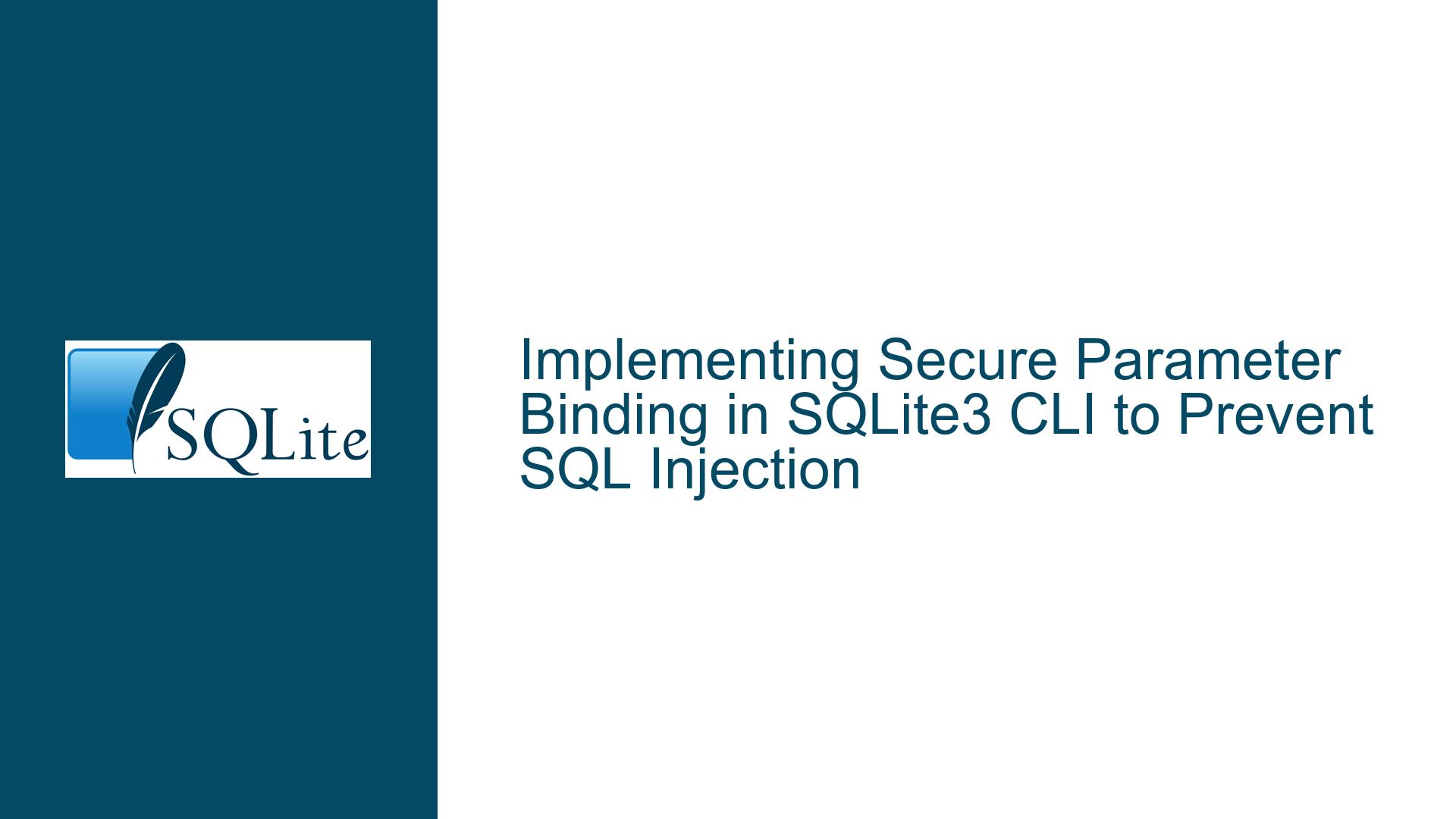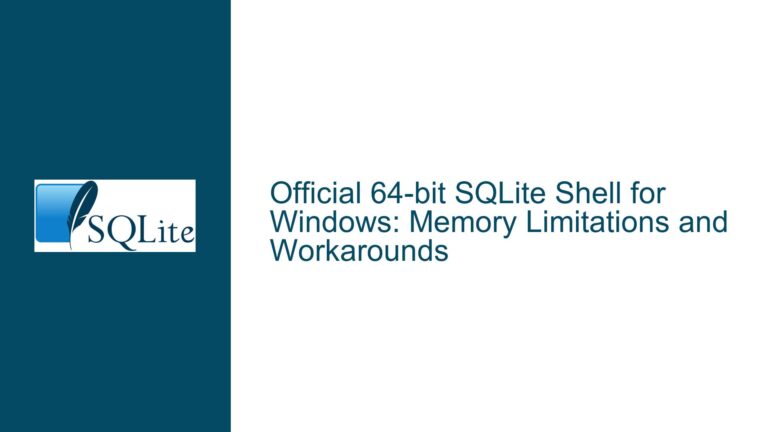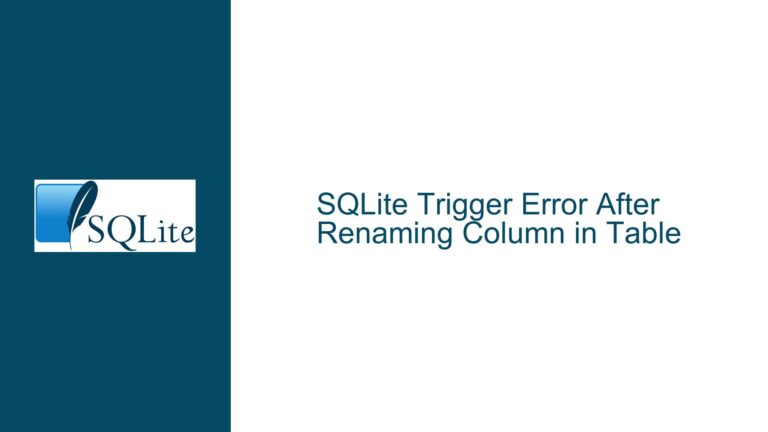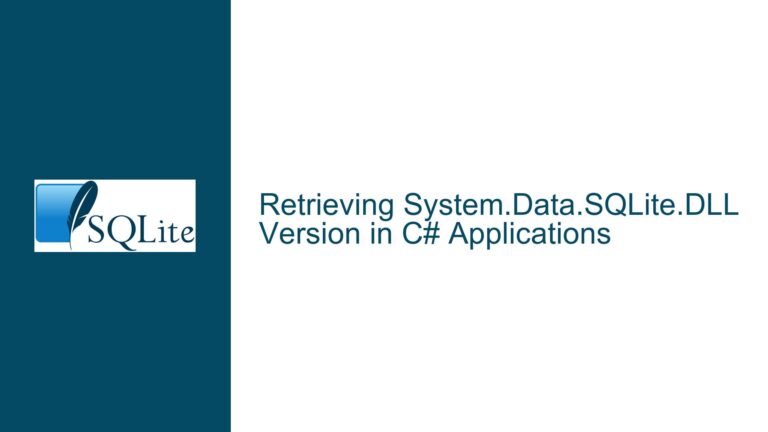Implementing Secure Parameter Binding in SQLite3 CLI to Prevent SQL Injection
Understanding the Need for Secure Parameter Binding in SQLite3 CLI
The SQLite3 command-line interface (CLI) is a powerful tool for interacting with SQLite databases, offering a text-based user interface (TUI) that allows users to execute SQL commands, manage databases, and perform various administrative tasks. However, one of the challenges faced by users of the SQLite3 CLI is the need to handle data from external sources securely, particularly when dealing with user-supplied data that may contain malicious content aimed at exploiting SQL injection vulnerabilities.
SQL injection is a well-known security vulnerability that occurs when an attacker is able to manipulate an SQL query by injecting malicious SQL code. This can lead to unauthorized access to data, data corruption, or even complete control over the database. In the context of the SQLite3 CLI, the risk of SQL injection arises when user-supplied data is directly incorporated into SQL queries without proper sanitization or parameterization.
The current .parameter set command in the SQLite3 CLI does not provide true key/value binding, which means that users must manually sanitize and escape data to prevent SQL injection. This process can be error-prone and cumbersome, especially when dealing with complex data types such as JSON or binary data. The lack of a robust parameter binding mechanism in the SQLite3 CLI forces users to rely on external tools or custom scripts to ensure data security, which can be inefficient and may introduce additional vulnerabilities.
To address this issue, there is a proposal to implement a new .parameter bind command in the SQLite3 CLI that would allow users to securely bind key/value pairs to SQL queries. This command would accept raw byte content as the value, eliminating the need for manual escaping and reducing the risk of SQL injection. Additionally, the proposed command would support reading values from files, further enhancing its utility for handling large or complex data sets.
Exploring the Limitations of Current Parameter Handling in SQLite3 CLI
The current .parameter set command in the SQLite3 CLI is designed to set named parameters that can be used in subsequent SQL queries. However, this command does not provide true parameter binding, which means that the values assigned to parameters are not securely bound to the query. Instead, the values are simply substituted into the query as-is, which can lead to SQL injection vulnerabilities if the data is not properly sanitized.
For example, consider a scenario where a user needs to insert a JSON object into a database using the SQLite3 CLI. The JSON object may contain special characters such as quotes or backslashes that need to be escaped to prevent SQL injection. With the current .parameter set command, the user would need to manually escape these characters before assigning the value to the parameter. This process is not only time-consuming but also prone to errors, as the user may inadvertently introduce vulnerabilities by failing to properly escape all special characters.
Moreover, the current .parameter set command does not support the direct binding of binary data or large text values. Users who need to handle such data must resort to workarounds, such as saving the data to a temporary file and using the readfile() function to read the data into a parameter. This approach is not only cumbersome but also introduces additional security risks, as the temporary file may be accessible to other users or processes on the system.
The limitations of the current .parameter set command become particularly apparent in automated workflows where data is received from external sources and must be processed without manual intervention. In such scenarios, the lack of a secure parameter binding mechanism can make it difficult to ensure data integrity and security, especially when dealing with untrusted data.
Implementing a Robust Parameter Binding Mechanism in SQLite3 CLI
To address the limitations of the current .parameter set command, a new .parameter bind command could be implemented in the SQLite3 CLI. This command would provide true key/value binding, allowing users to securely bind parameters to SQL queries without the need for manual escaping or sanitization.
The proposed .parameter bind command would accept raw byte content as the value, which would be directly bound to the parameter without any interpretation or modification. This approach would eliminate the risk of SQL injection, as the value would be treated as a literal string rather than part of the SQL query. Additionally, the command would support reading values from files, making it easier to handle large or complex data sets.
For example, consider a scenario where a user needs to insert a JSON object into a database using the SQLite3 CLI. With the proposed .parameter bind command, the user could simply bind the JSON object as a raw byte value, without the need for manual escaping. The command would ensure that the JSON object is securely bound to the query, preventing any potential SQL injection attacks.
The implementation of the .parameter bind command would also involve extending the SQLite3 CLI’s parser to handle raw byte content. This would require careful consideration of the command’s syntax and behavior, particularly with regard to handling spaces, null bytes, and other special characters. However, the benefits of a secure and robust parameter binding mechanism would far outweigh the challenges of implementation.
In addition to the .parameter bind command, the proposal also includes the introduction of .parameter bindfile and .parameter bindblob commands, which would allow users to bind values from files directly to parameters. These commands would leverage the existing .read command’s functionality, making it easier to handle large or complex data sets without the need for temporary files or external tools.
Overall, the implementation of a robust parameter binding mechanism in the SQLite3 CLI would greatly enhance the security and usability of the tool, particularly in automated workflows where data integrity and security are paramount. By providing a secure and efficient way to bind parameters to SQL queries, the SQLite3 CLI would become an even more powerful tool for managing SQLite databases.
Conclusion
The need for secure parameter binding in the SQLite3 CLI is evident, particularly in scenarios where data is received from external sources and must be processed without manual intervention. The current .parameter set command does not provide true key/value binding, forcing users to manually sanitize and escape data to prevent SQL injection. This process is error-prone and cumbersome, especially when dealing with complex data types such as JSON or binary data.
The proposed .parameter bind command would address these limitations by providing a secure and efficient way to bind parameters to SQL queries. By accepting raw byte content as the value, the command would eliminate the need for manual escaping and reduce the risk of SQL injection. Additionally, the command would support reading values from files, making it easier to handle large or complex data sets.
The implementation of the .parameter bind command would require careful consideration of the SQLite3 CLI’s parser and syntax, but the benefits of a secure and robust parameter binding mechanism would far outweigh the challenges of implementation. By enhancing the security and usability of the SQLite3 CLI, the proposed command would make it an even more powerful tool for managing SQLite databases in a wide range of scenarios.






